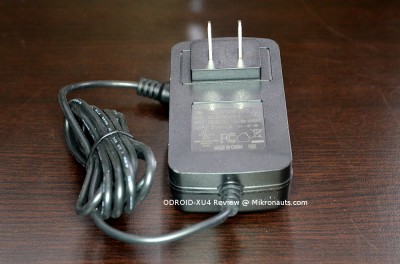Hardkernel ODROID XU4 Review
Power Utilization
(Click on image for larger version)
In the past, I have used a RS232 equipped Syscomp multi-meter to measure current.
When I tried to use it to measure the current consumption of the ODROID-XU4, the XU4 entered an endless reboot cycle. Obviously, the meter was dropping the voltage too much.
For this review, I quickly rigged up one of the ACS712 based current measurement modules to my data acquisition setup to measure the XU4’s power consumption.
Please note that this was a quick-and-dirty experimental setup, and it has not yet been calibrated to my satisfaction – but at least it let me measure the power consumption 🙂
| ODROID XU4 power | Amps | Watts |
| Idling – login | 0.422 | 2.1 |
| Idling – desktop | 0.838 | 4.2 |
| Chromium – desktop | 1.280 | 6.4 |
| Chromium – Roar 720p | 2.633 | 13.2 |
| Kodi YouTube – Roar 720p | 1.696 | 8.5 |
| Kodi Veevo – Roar 1080p | 1.914 | 9.6 |
Ok, there is no doubt that the ODROID-XU4 uses more power… but it does provide a lot more performance!
Once I calibrate my new current logging setup I plan to run some more accurate (and stressful) power consumption tests.
Support
When I started to test the XU4 Shifter Shield, I ran into a fairly annoying issue.
I could not export the GPIO pins to make them available from a terminal (or anywhere else for that matter).
I needed to export them so that I could blink LED’s (always very important), and so that I could reset RoboPi (very useful).
I looked on the wiki, and the example of how to export did not work for me.
I asked for support on the ODROID Forum, and I actually received several prompt replies from ODROID staff!
My issue with being unable to export GPIO’s turned out to be two fold:
1) I needed to update to the latest kernel
2) it was not sufficient to “sudo 174 >/sys/class/gpio/export”
You have to get a root shell using either
sudo su
or
sudo -s
Then type the export in that shell – a plain sudo won’t do.
Once that was out of the way, I was happily blinking lights!
wiringPi was also made available just a couple of days after I asked about it.
Conclusion
The ODROID-XU4 is a great little high performance octo-core ARM single board computer. It is by far the fastest ARM based single board computer I have used to date, seriously out performing the Raspberry Pi 2 and other single board computers I have tested.
Currently, the XU4 needs better video codec support outside of Kodi, and the current codecs used by Kodi have problems with 1080i MP4 files. Based on the improvements I saw for the ODROID-C1, I strongly suspect that improvements will come quickly.
For now, do yourself a favour, and
sudo apt-get install smplayer
for a much better viewing experience than VLC.
If you want to use GPIO’s at all, make sure you order a XU4 Shifter Shield when you order your XU4, as the 30+12 pin GPIO headers use 1.8V signals. I will be publishing my XU4 Shifter Shield review soon.
For best performance, get an eMMC module (16GB or 32GB) for your root file system. You can add an SD card, USB flash drive, USB hard drive, or network mount your data partition.
Hardkernel should look into alternate cooling solutions, as the fan they currently supply is too loud for the XU4 to be used as a media centre – my ATX power supplies (granted, they are “silent” supplies) are quieter.
What I liked:
- VERY snappy Big.Little octal core performance
- 2GB LPDDR3
- USB3.0
- Gigabit Ethernet
- eMMC 5.0 performance
- boot selector switch (uSD & eMMC)
- Ubuntu Mate
- wiringPi port
What I did not like:
- LOUD fan
- no SATA
- 1.8V GPIO (Shifter board fixes this at an added cost)
- no RPi.GPIO port (for now at least)
Related Links
- ODROID XU4 Shifter Shield Review
- ODROID C1 Review
- Raspberry Pi 2: Raspbian vs. Linero (ARMv6 vs ARMv7)
- Raspberry Pi Model A+ Review
- Raspberry Pi Model B+ Review
- Banana Pi Review
- Banana Pro Review
- MIPS Creator CI20 Review
- Ameridroid product page for the XU4 (for ordering)
- ODROID-XU4 Wiki
- Raspberry Pi Model B+ USB WiFi Adapter Tests
- Banana Pi USB WiFi Adapter Tests
- Elf RoboPi/Raspberry Pi Robot
- RoboPi product page
- Pi Rtc Dio product page
- Pi Jumper product page
- EZasPi product page
Review Index
- Page 1: Introduction, Does XU4 look like a C1 or RPi2?
- Page 2: A Closer look at the ODROID XU4
- Page 3: ODROID-XU4 Tour (continued)
- Page 4: Feature Comparison
- Page 5: Operating Systems, Multimedia
- Page 6: Software Compatibility & Hardware Compatibility
- Page 7: WiFi Compatibility & Documentation
- Page 8: XU4 Benchmarks: Booting, Apps, Compiling Emacs
- Page 9: XU4 Benchmarks: SysBench, iperf, nBench
- Page 10: XU4 Benchmarks: Unix Bench, hdparm, dd
- Page 11: Power Utilization, Support, Conclusion
